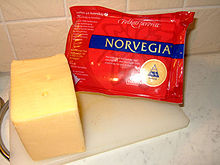NORVEGIA — regnum Europae septentrionalis versus Oceanum Germanicum situm, vulgo Norweg, quae est, si interpreteris Septentrionalis Via. Nort enim Germanicâ linguâ. Septentrionem significat, Weg, viam. Fuit regnum Norvegiae aliquandiu florens, imperiumque… … Hofmann J. Lexicon universale
Norvegia — er latin for Norge … Danske encyklopædi
Norvegia Rock — (54°24′S 3°25′E / 54.4°S 3.417°E / 54.4; 3.417) is a submerged rock with less than 2 m of water over it, lying off the north coast of Bouvetøya, approximately 0.5 nautical miles (0.9 km) east nor … Wikipedia
Norvegia Bay — (68°45′S 90°42′W / 68.75°S 90.7°W / 68.75; 90.7) is a cove at the north side of Cape Ingrid on the west side of Peter I Island. Named after the Norvegia, the No … Wikipedia
Norvegia Point — (54°27′S 3°21′E / 54.45°S 3.35°E / 54.45; 3.35) is a point 2 nautical miles (3.7 km) south of Cape Circoncision on the west side of Bouvetøya. First roughly charted from the … Wikipedia
Norvegia-Kap — 71.333333333333 12.3 Koordinaten: 71° 20′ 0″ S, 12° 18′ 0″ W … Deutsch Wikipedia
Norvegia — (Italian Norway); (Latin Norway) appears on early maps of the east coast of North America over an area extending from the Bay of Fundy to Florida and known for its Norse viking explorations and settlements in pre Columbian times; sometimes… … Eponyms, nicknames, and geographical games
Norvègia — Nourvejo f. Norvège … Diccionari Personau e Evolutiu
Mount Norvegia — (67°51′S 48°8′E / 67.85°S 48.133°E / 67.85; 48.133) is a large ice covered mountain, 1,340 m, standing 6 nautical miles (11 km) north of Mount Christensen … Wikipedia
Cape Norvegia — (coord|71|20|S|12|18|W|) is a prominent cape on the coast of Queen Maud Land which marks the northeast extremity of Riiser Larsen Ice Shelf. It was discovered by Commander Hjalmar Riiser Larsen in February 1930 while on an airplane flight from… … Wikipedia

